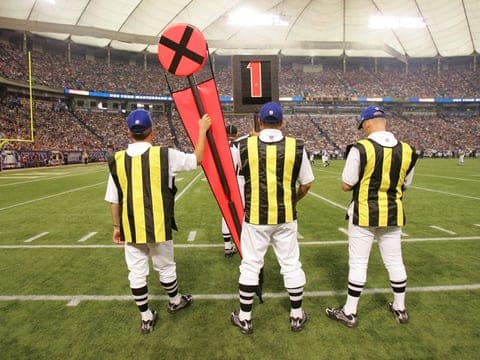There are important groups of people that mostly go unnoticed during a football game, the chain crews.
The primary purpose of this group of people is to properly indicate the down and distance the offense must gain in order to get a first down or another series of downs. At the beginning of every new series, the down indicator, or box, is set up first on the new line of scrimmage. Specifically, it is supposed to be placed on an invisible line passing through the very front of the ball. Once the down indicator is properly placed, the back stake of the chain is set up using the down indicator as the beginning point. The chains are then stretched out 10 yards with the front stake marking the spot for the next first down. Once the chains are properly placed, a clip is attached to the chain on the back of the yard line closest to the down indicator. This is a preventative measure in case the chains have to be pulled out of the way when players run out of bounds. If this happens, the chains can be set back up using the clip as a reference point.
The chain crew is made up of a minimum of three people. There’s one assigned to the down indicator and the other two hold the end stakes. With a three-person crew, the person working the box will attach the clip to the chain. This routine is repeated throughout the entire game. A three-person crew is very typical in recreational leagues, middle school and JV high school games.
As you move up in level of play, additional members are added to the chain crew. The first addition is usually a person responsible for placing the clip. Usually in high school, you won’t see more than four people working the chains.
In college and professional football, the number of people on the chain crew can grow to as many as 10 or 12. Some games will have a complete set of chains on both side lines. There is also an individual who is responsible for recording the fouls during the course of a game that is part of the chain crew.
With the advancement is technology of broadcasting games on TV, pylons with embedded cameras are placed on the sideline with the front stake. It not only gives a cool look on TV, but this angle can prove important during the reply process. Another individual must be added to the chain crew to handle this responsibility.
As a Head Linesman, I was responsible for the chain crew and how they functioned throughout the game. An hour or so before kickoff, I would go meet with the chain crew. Even though they knew what they were doing, I would go over many details just to set the tone for how we were going to work together during the game. Some members of the chain crew heard me go through my same routine 40 or 50 times during their time as a chain crew member. The members of the chain crew were pretty much the same, year after year.
The process we followed to measure for a first down was always the same. The down indicator would first move to the front stake. Then I would pick up the chain where the clip was attached. I would let both people holding the stakes that it was time for us to jog out to where the ball was placed. I would set the clip down on the back of the same yard line I started from. The person holding the front stake would hand it off to the Umpire where he would stretch it out on one side of the ball. The Referee would look to see if the ball was touching or beyond any part of the front stake. If it was touching, it was a first down. If not, the next down in the series would be played.
If it was determined to be a first down, I would simply let go of the chains and they would be reestablished as they would normally be during the game. If it was determined not to be a first down, I would take the chains back to the sideline, set the clip where it was originally located and set the chains back in place. The box would be set according to the distance needed for the first down.
Normally during the course of a game, you would have at least one measurement. If you had more than two, it was time to have a talk with your counterpart across the field. That official was responsible for letting the crew know if it was or wasn’t a first down. If it was close, the Referee would have the discretion to make a measurement.
I met many wonderful people during my 31-year career. As time progressed, I got to meet some of their children as they grew up and, themselves, becoming members of the chain crew. During timeouts or other breaks in the game, you had a chance to talk with the members of chain crew. It was always nice to have one of them ask how things were going at home or how my children were doing in school. You simply got to know one another.
